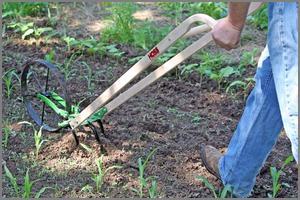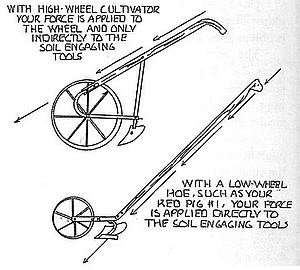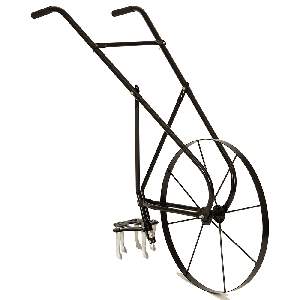Wheel Hoe Buying Guide
*only for brands currently available in the USA
What is a Wheel Hoe?

What a wheel hoe is used for depends on what attachment is fastened to it. Common attachments include teeth for cultivating, blades for weeding, and plows. But there are additional specialty tools, so the more attachments available for a brand, the more useful it is.
Also see our Wheel Hoe FAQ page for answers to a variety of questions.
Comparison of wheel hoes from Glaser, Hoss, Valley Oak, Terrateck, and Euro
In order to compare apples to apples, we researched the 5 modern wheel hoe brands. We are presenting a comparison of their basic features, and the retail prices for a single-wheel model outfitted with a set of cultivator teeth and a weeding hoe. We feel that these two attachments are the minimum to make the tool useful in the garden all season.
For each description below, the brand name is linked to the site we got the pricing and data from.
Glaser Professional / single wheel hoe

- model = Single Wheel
- option for double wheel = Yes
- wheel type = 12" pneumatic
- handles type = Steel
- Made in Switzerland
- Base unit + cultivator teeth + 8" hoe = $697
Hoss Standard / single wheel hoe

- model = Single Wheel
- option for double wheel = Yes
- wheel type = 15" steel
- handles type = Wood
- Made in USA
- Base unit + cultivator teeth + 8" hoe = $283

- model = Single Wheel
- option for double wheel = No
- wheel type = 12" steel
- handles type = Steel
- Made in USA
- Base unit + cultivator teeth + 8" hoe = $386

- model = Single Wheel
- option for double wheel = No
- wheel type = 11" plastic
- handles type = Steel
- Made in Hungary
- Base unit + cultivator teeth + 8" hoe = $199

- model = Single Wheel
- option for double wheel = Yes
- wheel type = 12" pneumatic
- handles type = Steel
- Made in France
- Base unit + cultivator teeth + 11" blade hoe = $565
Wheel Cultivators
What is the difference between a wheel hoe and a wheel cultivator?

Modern wheel hoes are designed to be easy to hook a wide variety of attachments to. Wheel cultivators usually only did plowing and cultivating, while the new wheel hoes will do both those tasks plus weeding, seeding, disc harrowing, and more.
High Wheel or Low Wheel: Which is better?
 Small Farmer's Journal
Small Farmer's Journal
Fast forwarding 100 years to today, the debate is over and the Low Wheel Hoe was the winner. The deciding factors were physics (see the drawing), and the ability to mount a wider range or attachments.
The physics and force advantage is shown well in the drawing. But the ability to securely attach a wider variety of tools was also important. As the use of these tools spread, so did the tasks they could handle. Besides the initial cultivator tines and weeding sweeps that all the models had, a wider variety of plows for furrowing, hilling, and even turning the soil began to appear, and these needed a stronger structure to fasten to. Then in about the 1980's the Oscillating Hoe attachments championed by Elliot Coleman appeared. After that came Seeder attachments which required the sturdy broad mounting surface that Low Wheel units provided.
The last High Wheel Cultivator...
 Earthway model
Earthway model
Here are the base prices. The steel-handled version come standard with 3 attachments: a 5-tine cultivator,
a turning plow, and a furrowing plow:
● Steel-handled High Wheel 6500 = $160
● optional 8" oscillating hoe attachment = $64
Which wheel hoe brand is right for you?
Only you can decide that, but we do hope that the information we have collected helps you pick one. There are lots of things that can sway people's decisions. If all you will ever want to do is weed and cultivate, then any of them will work. But if you want the option to do something special in the future, like planting seeds, or straddle weeding, then your options will narrow. I have even talked to people who made their decision based on cosmetics such as the look of the handles or the color of the frame.
Happy Gardening! and feel free to contact us if you want a little more help deciding.
● Additional wheel hoe insights, and reviews...
Below is collection of interesting bits about these tools that we found while researching this article. Enjoy!
Excerpt from the
MOTHER EARTH NEWS - June/July 2010:
Author: Cheryl Long
The Wheel Hoe: A Modern Weed Slayer
"...Just in time for the summer weed season, we've chosen the wheel cultivator as another Tool for Wiser Living. If you have a large garden, this old-time tool can really reduce weeding chores. Thomas Greiner describes it in his book, How to Make the Garden Pay, published in 1890:
But the tool of all tools, the modern weed slayer, the great labor saver, the greatest horticultural blessing
of the age - that is the modern wheel hoe. This above all others frees the gardener from undesirable work, cuts down
the labor account one-half, and makes tillage light and pleasant. The advantages connected with the possession of
one of these tools cannot be overstated, nor emphasized too strongly, nor told too frequently. This tool reduces the
unpleasant task of weeding to a minimum. Now the half-grown boy runs the wheeled hoe up and down the rows of vegetables
'for fun' and recreation, and accomplishes in one-half hour what a man with a hand hoe could not perform in a whole
day...."
Excerpt from the
Countryside & Small Stock Journal - January 1999:
Author: Jeff Rast
An Introduction to Garden Cultivators
"...Push cultivators come in several varieties, price ranges and performance levels. The oldest and probably
still the most common is the high-wheeled cultivator. It simply consists of a large (24 inches), single wheel with two
handles for the operator and one or more attachments. Mine comes with cultivating teeth, a duck-foot sweep and
a furrowing attachment. The design allows me to cultivate between rows much faster than with a hand hoe and I
can finish without a backache. Most high wheel versions cost between $75 to $100.
Another version of the wheel hoe for sale now has a much smaller wheel (9 inches) and a different angle of attachment of the
handles to the wheel. Eliot Coleman states in his book The New Organic Grower that he prefers the design of the
smaller models because they transfer the force exerted by the operator more directly to the working part. Makes
sense. Furthermore, Coleman says that it is the "best cultivation tool for inter-row work on this 5-acre
scale." On his smaller wheeled model, Coleman actually has a stirrup hoe rather than the cultivating teeth or sweep.
Low wheel models tend to be sturdier than the high wheel types and have more "engineering" in them. Prices
reflect this difference and can run up to about $285....."
Excerpt from
THE WASHINGTON POST - 8/19/2010:
Author: Barbara Damrosch
Home gardeners should take wheel hoes for a spin in their back yards
"...A few generations ago, wheeled cultivators were standard equipment for market gardeners and for home gardeners who
grew much of their own food. An octogenarian neighbor who was raised on a large farm recalls how 20 workers
would show up each morning and reach for just that implement. In those times, it was the tool by which large
acreages were managed. Few would recognize it today.
A wheel hoe is simply a hoe blade mounted on a wheel. The wheel is there to lessen the work of moving the blade
along, keep it a consistent distance from the soil and lend force to its cutting action. Wheel cultivators are designed
so that you can weed close to crops planted in straight rows. They also do a championship job on dirt paths between
beds. Nothing else makes such quick work of weeds in hard, trodden earth that would normally have you on your knees,
stabbing peevishly with your trowel.
Modern versions of the wheeled hoe are more efficient than the ones my neighbor remembers because they use an
oscillating blade, like that of a hula hoe, which cuts on both the forward and back strokes. Walk at a comfortable pace,
pushing back and forth, and weeds are severed just below the surface so that none can regrow. Weeds too small to see
are dispatched as well...."
Excerpt from The History of the Wheel Hoe
by Author:
Professor John R Stilgoe
excerpted from "Scientific Authority & Twentieth Century America"
Throughout its history the firm emphasized its push cultivators and automatic seed drills, devices equipped with all manner of gadgets
and practically impossible to describe briefly. Wheeled hoes came with one wheel or two: single wheel machines typically ran between
rows of plants and sliced off or tore up weeds, while two-wheel machines straddled one row of plants and sliced off weeds on either
side.....The firm claimed that with wheel hoes "one can plant four times his usually acreage of hoed crops from drilled
seeds, without fear of being caught in their cultivation," Fourfold efficiency increases depended on the seed drill as well,
and Allen and Company manufactured combination tools like the "Combined Drill, Wheel Hoe, Cultivator, Rake, and Plow,"
an 1892 near-top-of-the-line tool. "Every purchaser of this machine will find it an excellent seed sower; a first-class double-wheeled
hoe while plants are small; an excellent furrower; an admirable push cultivator; a capital garden rake;
a rapid and efficient wheel garden plow, and it is without an equal in a variety of tools, easy adjustment, lightness, strength, and
beauty, and as a practical everyday time and labor saver." Allen tools had very specific applications, indeed, and in the end, that
proved important to the man - or woman - with five acres of celery to plant and cultivate...
● read the rest of this Planet Jr History article

